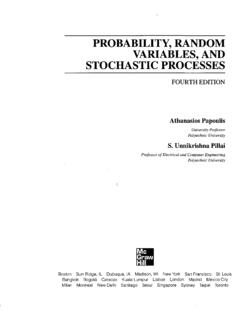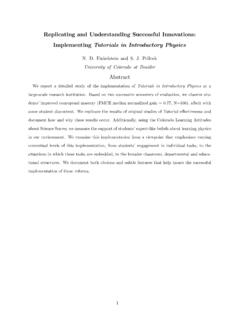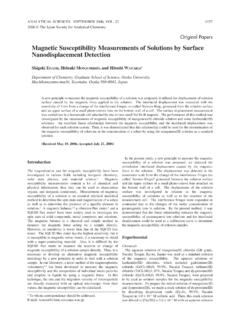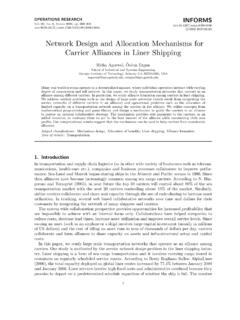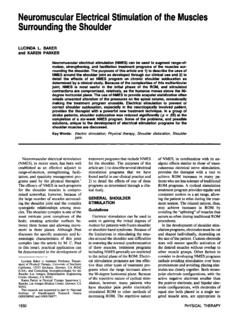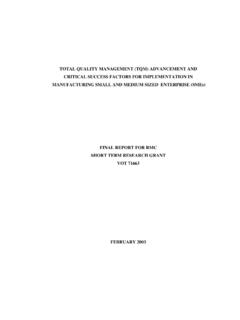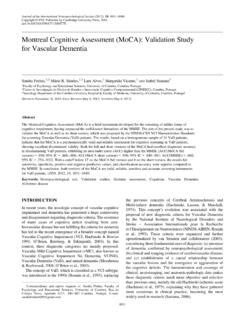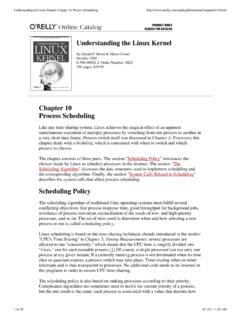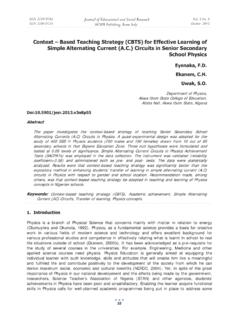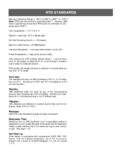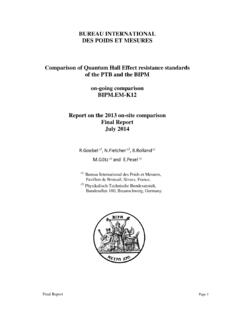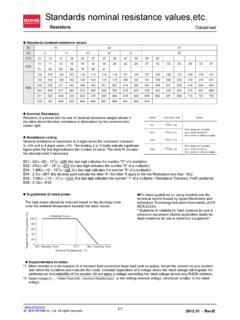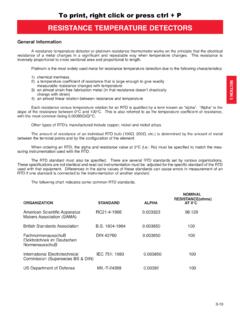Transcription of [J. Res. Natl. Inst. Stand. Technol. 107 Stability of ...
1 Volume 107, Number 5, September October 2002 Journal of Research of the National Institute of standards and Technology[J. Res. Natl. Inst. Stand. , 393 399 (2002)] Stability of Standard Electrolytic ConductivitySolutions in Glass ContainersVolume 107 Number 5 September October 2002 Rubina H. ShreinerNational Institute of standards andTechnology,Gaithersburg, MD Stability of solutions having an elec-trolytic conductivity, ,of5 S/cm to100 000 S/cm packaged in glass screw-cap bottles, glass serum bottles, and glassampoules was monitored for 1 year to2 years. The conductivity was deter-mined by measuring the ac resistance ofthe solution. Mass loss was also moni-tored for solutions packaged in bottles. Thesolutions were prepared using KCl in wa-ter ( 100 S/cm) or KCl in 30 % (bymass) n-propanol 70 % (by mass) water( 15 S/cm).
2 The conductivity changeswere compared by packaging type andby nominal . The main causes of the changes are evaporation (screw-cap bot-tles) and leaching (screw-cap bottles, serumbottles, and ampoules). Evaporation is de-termined from mass loss data; leachingoccurs from the glass container with nochange in mass. The choice of optimalpackaging, which depends on the con-ductivity level, is the packaging in which changes the least with time. Ampoulesare the most suitable packaging forstandards having nominal values of500 S/cm to 100 000 S/cm. Screw-capbottles are most suitable for standardshaving a nominal of 5 S/cm to100 words:conductivity; containers;packaging; potassium chloride; Stability ; :August 19, 2002 Available online: IntroductionThe measurement of electrolytic conductivity, ,isused to monitor the ionic content of solutions ( , fruitjuices, soft drinks, dialysis fluid, and natural waters) andthe purity of water ( , drinking water, wastewater,process water).
3 Many industries, including pharmaceu-tical, power, and health care, rely on electrolytic conduc-tivity standards to calibrate electrolytic conductivitymeters and cells. The availability of standards with ac-curate and stable values is crucial to those monitoring equipment is calibrated by measuringthe resistance of a standard,Rc, having a known conduc-tivity, c, in a conductivity cell. The cell constant,Kcell,is then determined by Eq. (1),Kcell= cRc.(1)The accuracy of this calibration, and the subsequentmeasurements, is determined by the accuracy of thestandard. The conductivity of a solution, s, can then bedetermined by Eq. (2), s=Kcell/Rs(2)whereRsis the resistance of the solution measured in acell with a practical consideration in the accuracy of elec-trolytic conductivity standards , as with all standards , istheir Stability , or change in certified value versus there is a large body of data with regard tostandard electrolytic conductivity solutions, , Refs.
4 [1-10], data regarding the long-term Stability of the stan-dard solutions are lacking. Obviously, any change from393 Volume 107, Number 5, September October 2002 Journal of Research of the National Institute of standards and Technologythe certified value will compromise the accuracy of thestandard at the time of use and must be considered inestablishing both the uncertainty in and the expirationdate of the reference material. This paper reports thechange of in solutions packaged in a variety of con-tainer types observed for several prepares and certifies electrolytic conductivitystandards in the range of 5 S/cm to 100 000 S/cm asSRMs (Standard Reference Materials) 3190 to certificates for these SRMs typically expire in1 year to 2 years because of the difficulties in maintain-ing their long-term Stability .
5 Stability is one of the fac-tors in the certified uncertainties, which vary % to 4 % in the most recent certifications of thehighest and lowest conductivity standards in this group,respectively. Neglecting the contribution of instability,the certified uncertainties of these SRMs would be inthe range of % to 2 % (Table 1). The goal of thisstudy is to achieve an uncertainty close to the targetvalues for each SRM listed in Table of the containers in this study were glass. Evapo-ration and leaching are the two main problems withglass containers. Evaporation occurs through the spacebetween the cap and the bottle, causing a simultaneousmass loss and increase of the solution. The increasewould be approximately proportional to mass loss fromevaporation.
6 A increase of the solution with no massloss would be indicative of an increase in the ionicstrength from leaching. Three types of packaging havebeen tested: glass screw-cap bottles, glass serum bottles,and glass ampoules. The Stability of solutions ranging inconductivity from 5 S/cm to 100 000 S/cm was mon-itored. The causes of instability and the choice of thebest packaging type are Solution Preparation and PackagingContainers that were readily available to users andproducers of conductivity standards were chosen for thisstudy. Screw-cap bottles, serum bottles, and ampouleswere purchased commercially and were each made ofborosilicate glass [11, 12]1. The 500 mL screw-cap bot-tles had polypropylene plug seal caps.
7 The 100 mLserum bottles had aluminum caps, which were linedwith Teflon faced gray butyl septa. The 50 mL am-poules were sealed in a natural gas/O2flame. The glasscomposition of the screw-cap bottles and the ampouleswas significantly different from the glass composition ofthe serum bottles (Table 2). Thus, three parameters dif-fered among the bottles studied: closure type, glasstype, and volume to surface area were prepared using deionized water( < S/cm at delivery) and potassium chloride(reagent grade). Mixed aqueous-nonaqueous solutions(5 S/cm and 15 S/cm, only) were prepared usingn-propanol (assayed by the manufacturer at 100 %) anddeionized water. A total of fifteen solutions were sepa-rately prepared and monitored.
8 The solutions nominalconductivities, the packaging types, and the approxi-mate masses of KCl are displayed in Table 1. The solu-tions were thoroughly mixed and homogenized. All so-lutions were equilibrated with atmospheric CO2prior screw-cap bottle was filled with 500 mL ofsolution and immediately capped. The cap-bottle junc-ture of the screw-cap bottles used for the 100 S/cm and1000 S/cm solutions were wrapped in Parafilm (44 d1 Certain commercial equipment, instruments, or materials are identi-fied in this paper to foster understanding. Such identification does notimply recommendation or endorsement by the National Institute ofStandards and Technology nor does it imply that the materials orequipment identified are necessarily the best available for the preparationPackaging typeNominalTargetScrew-capSerumAmpoulesA pproximatemKCl /( S/cm)uncertaintya/(%)bottlesbottlesper kg of solution/(g)52 63aRelative expanded uncertainty at the 95 % confidence 107, Number 5, September October 2002 Journal of Research of the National Institute of standards and TechnologyTable of glass types used for each container% Composition as provided by the manufacturerComponentScrew-capped bottlesaSerum + + < < (F, MnO2,Fe2O3,Li2O, CeO2))
9 Ref. [11].bSee Ref. [12].after bottling for the 1000 S/cm solution; the day ofbottling for the 100 S/cm solution). Each serum bottlewas filled with 100 mL of solution and immediatelycapped. The mass loss of each screw-cap bottle andserum bottle was monitored. Each ampoule was filledwith 50 mL of solution (air head-space) and immedi-ately sealed in a natural gas/O2flame. All of the contain-ers for a given solution were filled and capped (orsealed) in 1 day. The mass loss of the 1000 S/cmsolution packaged in ampoules was monitored for thefirst 23 d. Ampoules that lost mass were discarded, sincemass loss indicated a pinhole. For the other solutionspackaged in ampoules, a vacuum was pulled on the sealof each ampoule.
10 If there were a hole in the seal of theampoule, liquid would be visible in the tubing. Anyampoule in which liquid was observed in the tubing of the containers were stored on shelves and/or inboxes in rooms with an air temperature of 20 C 5 the 2 year study, random units were selected formeasurement and each unit was only used once. A unit refers to the set of containers (1 screw-cap bottle,2 to 3 serum bottles, or 5 to 6 ampoules) needed toobtain a sufficient quantity of solution to perform onemeasurement (including necessary preliminary rinsesof the cell). Three to seven units were measured at eachtime period and the mean of these measurements wastaken as the value of the solution at that Equipment and Measurement MethodThe equipment used for the measurements has beenpreviously described [13].
